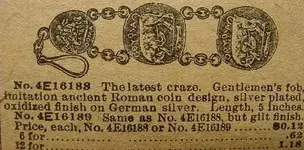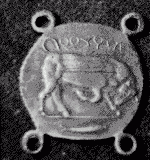ugotit22
Bronze Member
- Joined
- Dec 26, 2007
- Messages
- 1,771
- Reaction score
- 563
- Golden Thread
- 0
- Location
- The Dirty Shire
- Detector(s) used
- Whites DFX, and Whites IDX Pro
Hey guys
i went to this 1800's farm house today and come up with this in the front yard. It is copper about the size of a half dollar. It has what looks like a horses head with some strange symbols and one side. The other side looks like the bust of a women wearing a wreath around her head.
I have no idea what it could be.
any information would be great.
Thanks
Keith
i went to this 1800's farm house today and come up with this in the front yard. It is copper about the size of a half dollar. It has what looks like a horses head with some strange symbols and one side. The other side looks like the bust of a women wearing a wreath around her head.
I have no idea what it could be.
any information would be great.
Thanks
Keith
Attachments
Upvote
2








 I wonder if they were made and scattered to try and fool the scientific community at the time into believing the Carthagins were here first. It's my understanding that there are several die varieties and the coin looks quite crude (at least the engraving of the horse) compared to the original silver coins. I take it the text on the coin under the horse is non-sense? The guy was either a sloppy forgerer or he only had a picture of an original and couldn't make out the text. But if it was meant to fool, I can't believe someone would not get the text right. Maybe made for fun or novelty. I take it there are only 12 in existence still? Would love to read a book on these - what is the best source? Seems the professor's book is only 43 pages
I wonder if they were made and scattered to try and fool the scientific community at the time into believing the Carthagins were here first. It's my understanding that there are several die varieties and the coin looks quite crude (at least the engraving of the horse) compared to the original silver coins. I take it the text on the coin under the horse is non-sense? The guy was either a sloppy forgerer or he only had a picture of an original and couldn't make out the text. But if it was meant to fool, I can't believe someone would not get the text right. Maybe made for fun or novelty. I take it there are only 12 in existence still? Would love to read a book on these - what is the best source? Seems the professor's book is only 43 pages ? BTW, the best book on Piltdown Man controversy and an author who seems to have finally revealed the perpetrator of the hoax is entitled "The Piltdown Men" - excellent book and a lot bigger than 43 pages!
? BTW, the best book on Piltdown Man controversy and an author who seems to have finally revealed the perpetrator of the hoax is entitled "The Piltdown Men" - excellent book and a lot bigger than 43 pages! 






 your right it wouldn't take a expert long to tell the difference, once he had it in his hands, but I believe that the original one posted here never got sent to a expert
your right it wouldn't take a expert long to tell the difference, once he had it in his hands, but I believe that the original one posted here never got sent to a expert 